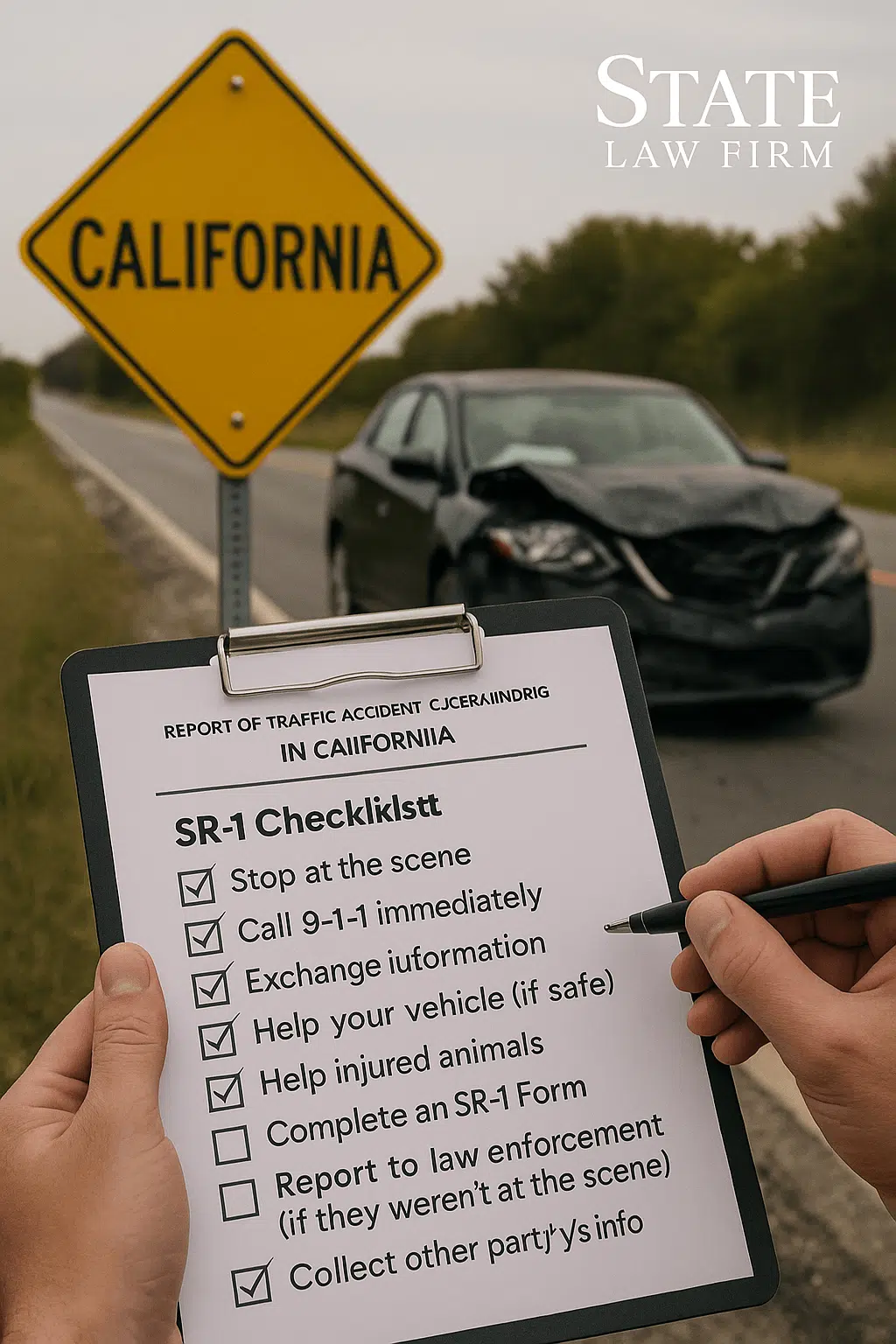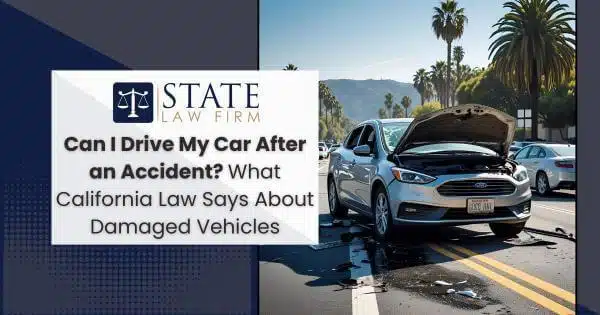Getting into a car accident—no matter how minor—can leave you with a flood of questions, one of the most common being: “Can I still drive my car?” In California, the answer isn’t always straightforward. Between safety concerns, insurance policies, and vehicle code compliance, knowing what to do next is essential to protect your well-being and your legal rights.
In 2022 alone, California reported over 216,000 injury-related crashes, according to the California Highway Patrol’s SWITRS data. While not all accidents leave cars inoperable, even seemingly minor issues—like a broken headlight or bent frame—can have serious legal and safety consequences if you continue driving without addressing the damage.
This article breaks down what California law says about driving a damaged vehicle, how to assess if your car is safe to operate, the risks of driving without repairs, and your rights as a driver. Whether you’re dealing with a bent bumper or considering filing an insurance claim, our team at State Law Firm’s Sherman Oaks office is here to guide you through it.
We’ll also touch on related topics, such as your responsibilities regarding vehicle modifications that may arise after an accident, especially if repairs alter your vehicle’s compliance with state regulations.
As a boutique personal injury law firm run by young, dedicated attorneys striving to win the more challenging cases, we believe in empowering clients with the knowledge they need. So let’s walk through what you should know before you get back behind the wheel.
Understanding California’s Laws on Vehicle Condition Post-Accident
California law requires all vehicles operating on public roads to meet basic safety and equipment standards, even after a collision. Under the California Vehicle Code, driving a car with critical damage—such as inoperative lights, broken mirrors, or compromised brakes—can subject you to penalties and liability.
After an accident, you’re legally obligated to:
- Ensure the vehicle is operable and safe.
- Comply with mandatory accident reporting if injuries or property damage exceed $1,000 (California Vehicle Code §16000).
- Avoid driving any vehicle with visible or structural damage that affects safety equipment.
If you’re unsure whether your car is roadworthy, it’s not worth the risk—you could be held responsible if another accident occurs due to unresolved damage.
Pro Tip: If your check engine light is on or if any dashboard warning indicators are active after the crash, that’s your car telling you not to drive it until it’s been looked at.
Assessing Your Car’s Damage: When Is It Safe to Drive?
Even a fender bender can leave hidden issues. Just because your car starts doesn’t mean it’s safe.
Key damage checkpoints before driving:
- Headlights, brake lights, and turn signals must all be functional.
- Tires and wheels: Look for bulges, punctures, or alignment issues.
- Steering and suspension: Pulling to one side or unstable handling flags
- Windshield and mirrors: Cracks or obstructions can lead to citations and make driving hazardous.
- Fluid leaks: Transmission, coolant, or brake fluid leaks need immediate attention.
If you notice any of these issues—or just feel uncertain—get a post-collision inspection by a trusted mechanic or body shop.
Pro Tip: Take photos of any visible damage immediately after the accident. This will help with both your insurance claim and legal documentation should you need to pursue compensation.
The Importance of Reporting Accidents and Insurance Considerations
After a car accident, your next steps aren’t just procedural—they’re legal. Failing to report the incident or follow California’s rules can cost you your license, your claim, and in some cases, even your freedom.
Whether it’s a minor fender bender or a major collision, here’s what you must do under California law, according to the California DMV:
California Car Accident Reporting Checklist
| What to Do | When & Why |
| Stop at the scene | Failing to stop may result in a charge for hit-and-run. |
| Call 9-1-1 immediately | Required if someone is injured, killed, or property is seriously damaged. |
| Exchange information | Share your name, driver’s license, insurance, registration, and current address. |
| Move your vehicle (if safe) | If no one is injured, get your car off the road to avoid impounding (VC §§22651 & 22651.05). |
| Help injured animals | If you hit an animal, contact the police or humane society—never leave them unattended. |
| Complete an SR-1 Form | Required within 10 days if injuries occurred or damage exceeds $1,000. File it with the DMV. |
| Report to law enforcement (if they weren’t at the scene) | Required if anyone was injured or killed and no officer responded. |
| Collect the other party’s info. | Get details like DOB, insurance company, policy number, and license plate number. |
Failing to complete the DMV’s SR-1 report can lead to license suspension, even if the crash happened on private property, and even if you weren’t at fault. It’s separate from any police or insurance report and must be filed by you, your attorney, or your insurer.
Pro Tip: Bookmark the SR-1 DMV page on your phone now so you won’t have to scramble to find it later.
Why All This Matters for Your Insurance
Here’s the reality:
- Delays in reporting can trigger policy violations or give insurers grounds to deny your claim.
- If you were uninsured at the time, you face license suspension—even if you weren’t at fault.
- If you drive away with visible damage or fail to report, you may be at fault, even if you weren’t.
Uninsured motorist claims, disputes over fault, and payout delays are all common. Don’t let a paperwork misstep compromise your recovery.
That’s where we come in. At State Law Firm, we help injured drivers cut through the red tape, hold insurers accountable, and make sure no small mistake derails your path to justice. Let us handle the forms—you focus on your healing.

The Risks of Driving a Damaged Vehicle: Legal and Safety Implications
Driving a damaged car isn’t just unsafe—it could make things worse legally.
The risks include:
- Receiving a citation for equipment violations (e.g., cracked windshield, broken taillights).
- Being found comparatively negligent if the damage contributed to a new collision.
- Insurance claim denial if further damage occurs and the vehicle isn’t repaired.
Worse yet, driving a visibly damaged car could undermine your credibility in any legal proceedings.
If there’s any doubt about your vehicle’s condition, consult with a professional before getting behind the wheel. It’s a small step that can protect both your safety and any future claims you may need to make.
Your Rights as a Driver After an Accident: What You Need to Know
California drivers have a right to seek compensation for:
- Vehicle repair or replacement
- Medical expenses
- Lost wages
- Pain and suffering
You also have a right to:
- Choose your repair shop—insurers can’t force you to use their preferred vendor.
- Challenge fault determinations made by insurers or the other party.
But the legal system can be tricky to navigate, especially when you’re also dealing with medical treatment, car repairs, or missed work.
That’s where our team at State Law Firm steps in. We’ve helped countless drivers across Southern California fight for what they’re owed. If the insurance companies are pushing back, or if you’re unsure about your next step, we’ll make sure you’re not left in the dark.
Ensuring Your Safety and Legal Compliance After an Accident
Getting back on the road after a car accident isn’t just about fixing a bumper—it’s about making sure you and your rights are protected every step of the way.
Here’s a quick recap:
- Don’t drive if the vehicle appears unsafe or damaged.
- Report the accident promptly to the proper authorities and your insurance provider.
- Get a professional inspection before resuming regular driving.
- Know your rights—and don’t settle for less than what you deserve.
If you’re still unsure whether your vehicle is legally drivable or if the insurance company is giving you the runaround, reach out to the legal team that gets results. The young, determined attorneys at State Law Firm aren’t just here to answer your questions—we’re here to fight for your future.


